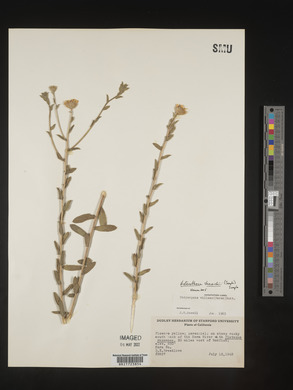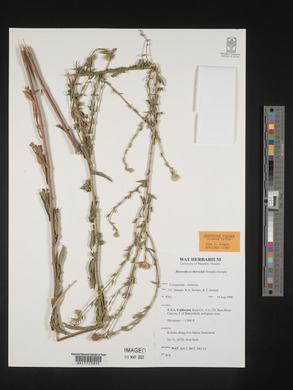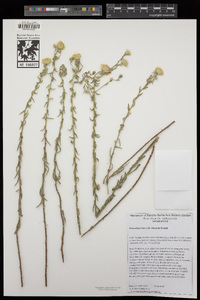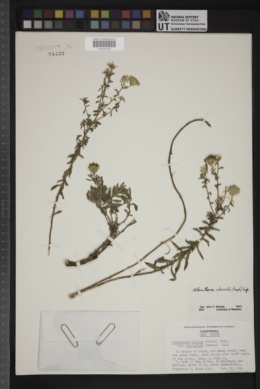Heterotheca shevockii
|
|
|
|
Family: Asteraceae
Shevock's False Golden-Aster
|
Perennials, (28-)50-131 cm; taprooted. Stems 1-35+, ascending to erect (sometimes brown proximally, sometimes ± brittle), sparsely strigose, moderately hispid (hairs often broken off in older stems), distally sparsely hispido-strigose and densely stipitate-glandular, abundantly long-hirsute. Leaves: proximal cauline subpetiolate to sessile, blades oblanceolate to lanceolate, 25-55 × 5-16 mm, bases convex-cuneate, margins entire, strigoso-ciliate, proximally long-ciliate, apices acute, mucronate, faces moderately hispido-strigose; distal blades sessile, linear-lanceolate to lanceolate-triangular, (17-)31-65 × 6-15 mm, reduced distally, bases abruptly convex-cuneate or rounded to sometimes subclasping, margins entire, usually revolute, faces sparsely to moderately long-hispido-strigose proximally, moderately to densely stipitate-glandular (branch leaves much reduced distally, linear to linear-oblanceolate). Heads (3-)5-20(-70) in paniculiform arrays, branches elongate on robust shoots. Peduncles 10-60+ mm, sparsely hispido-strigose, densely stipitate-glandular; bracts 3-10, proximal leaflike, greatly reduced distally, linear to linear-oblanceolate, distalmost phyllary-like (not surpassing heads). Involucres cylindro-turbinate to campanulate, 9-13 mm. Phyllaries in 5-6 series, unequal (outer lengths 1 / 5 - 1 / 4 inner), faces sparsely strigose especially along pronounced midnerves, densely stipitate-glandular. Ray florets 9-15(-18); laminae 5-8(-10) × 0.8-2 mm. Disc florets (31-)40-70(-80); corollas barely ampliate, 5-7 mm, tubes and throats sparsely strigose, lobes 0.3-0.8(-1.1) mm, lobes glabrous or sparsely strigose (hairs 0.04-0.27 mm). Cypselae monomorphic, obconic, compressed, 2-4.5 mm, ribs 8-12, faces moderately strigose; pappi off-white, outer of linear scales 0.25-1 mm, inner of 35-45 bristles 5-7 mm, longest weakly clavate (usually equaling or shorther than corollas). 2n = 36. Flowering (Jan-)Aug-Sep(-Nov). Sandy, gravelly soils and rock crevices along river in grass and open xeric pine and oak woods; of conservation concern; 400-900 m; Calif. Known only from the lower Kern River Canyon, Kern County, Heterotheca shevockii is distinguished from other species by its usually tall stems and lanceolate-triangular mid cauline leaves with usually revolute margins, its large heads and floral parts, and pappi bristles usually only about 90% the length of the disc corollas at flowering. Smaller plants are similar to H. villosa var. scabra, known in California from a few locations in the Little San Bernardino Mountains (1200-1300 m).
|




